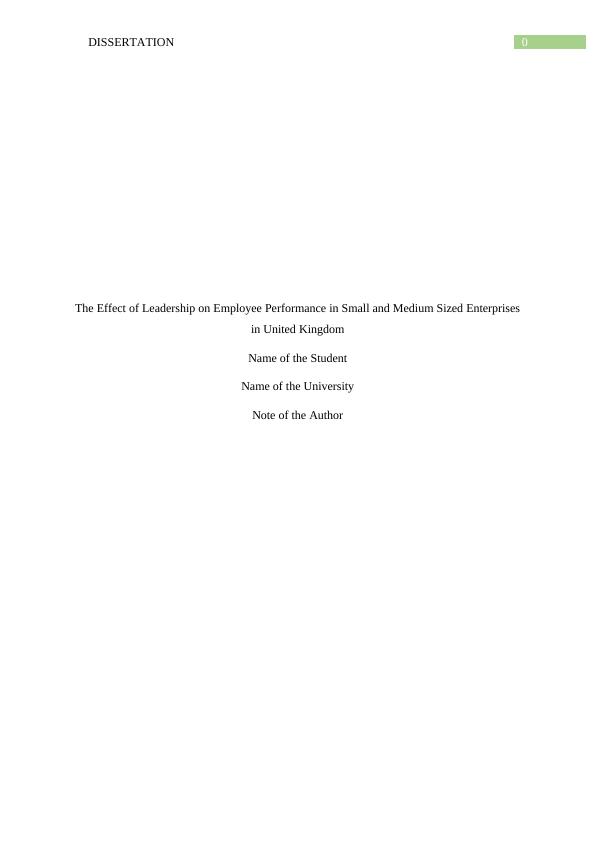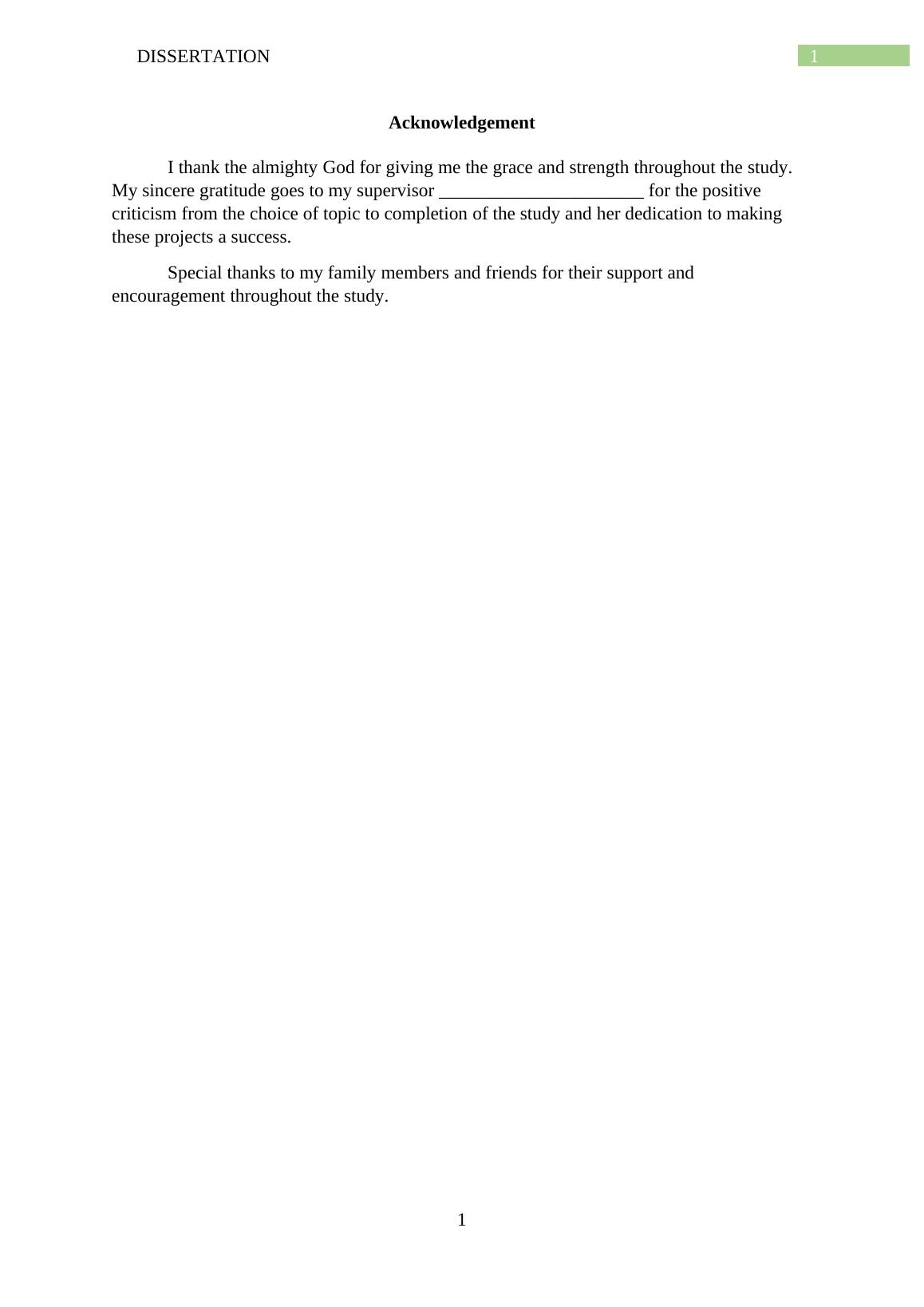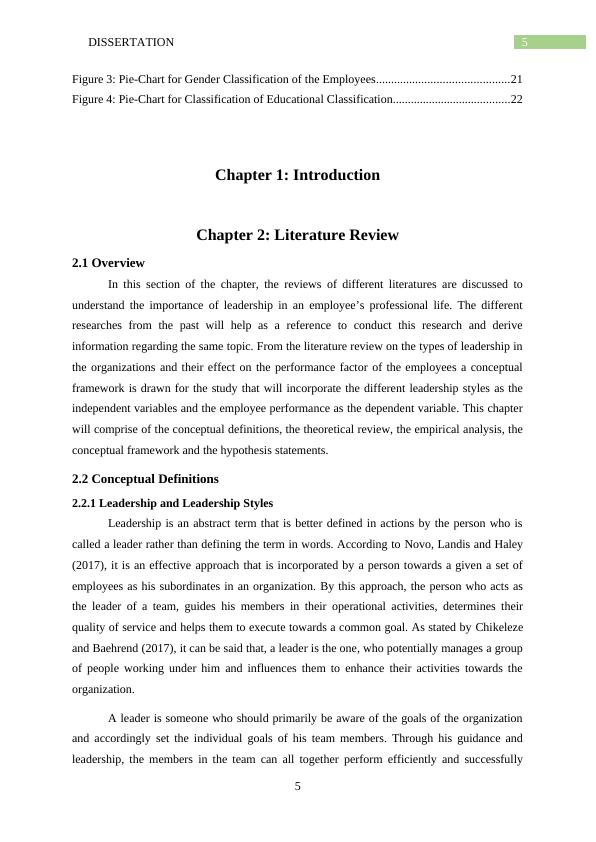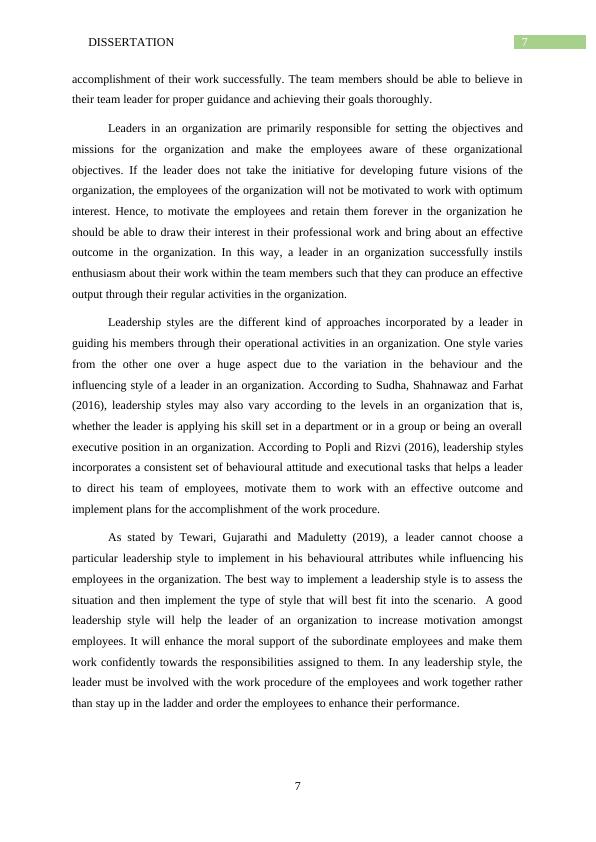The Effect of Leadership on Employee Performance
The assignment requires the completion of a topic agreement form for the dissertation on the effect of leadership style on employee performance in small and medium enterprises.
42 Pages12225 Words21 Views
Added on 2022-08-18
The Effect of Leadership on Employee Performance
The assignment requires the completion of a topic agreement form for the dissertation on the effect of leadership style on employee performance in small and medium enterprises.
Added on 2022-08-18
ShareRelated Documents
0DISSERTATION
The Effect of Leadership on Employee Performance in Small and Medium Sized Enterprises
in United Kingdom
Name of the Student
Name of the University
Note of the Author
The Effect of Leadership on Employee Performance in Small and Medium Sized Enterprises
in United Kingdom
Name of the Student
Name of the University
Note of the Author

1DISSERTATION
Acknowledgement
I thank the almighty God for giving me the grace and strength throughout the study.
My sincere gratitude goes to my supervisor ______________________ for the positive
criticism from the choice of topic to completion of the study and her dedication to making
these projects a success.
Special thanks to my family members and friends for their support and
encouragement throughout the study.
1
Acknowledgement
I thank the almighty God for giving me the grace and strength throughout the study.
My sincere gratitude goes to my supervisor ______________________ for the positive
criticism from the choice of topic to completion of the study and her dedication to making
these projects a success.
Special thanks to my family members and friends for their support and
encouragement throughout the study.
1

2DISSERTATION
Abstract
2
Abstract
2

3DISSERTATION
Table of Contents
Table of Table............................................................................................................................4
Table of Figure...........................................................................................................................4
Chapter 1: Introduction..............................................................................................................5
Chapter 2: Literature Review.....................................................................................................5
2.1 Overview..........................................................................................................................5
2.2 Conceptual Definitions.....................................................................................................5
2.2.1 Leadership and Leadership Styles.............................................................................5
2.2.2 Employee Performance..............................................................................................8
2.3 Theoretical Literature Review..........................................................................................9
2.3.1 Traits and Behavioural Theory..................................................................................9
2.3.2 Situational and Contingency Theory.........................................................................9
2.3.3 Transformational and Transactional Theory............................................................10
2.3.4 Transactional Leadership and Employee Performance...........................................10
2.3.5 Transformational Leadership and Employee Performance.....................................11
2.3.6 Laissez Faire Leadership and Employee Performance............................................12
2.3.7 Autocratic Leadership and Employee Performance................................................12
2.4 Empirical Analysis.........................................................................................................13
2.4.1 General Studies........................................................................................................13
2.4.2 Empirical Analysis...................................................................................................15
2.5 Research Gaps................................................................................................................16
2.6 Conceptual Framework..................................................................................................17
2.7 Statement of Hypothesis.................................................................................................17
Chapter 3: Research Methodology...........................................................................................19
Chapter 4: Data analysis...........................................................................................................19
4.1. Introduction...................................................................................................................19
4.2. Description of the Sample.............................................................................................19
3
Table of Contents
Table of Table............................................................................................................................4
Table of Figure...........................................................................................................................4
Chapter 1: Introduction..............................................................................................................5
Chapter 2: Literature Review.....................................................................................................5
2.1 Overview..........................................................................................................................5
2.2 Conceptual Definitions.....................................................................................................5
2.2.1 Leadership and Leadership Styles.............................................................................5
2.2.2 Employee Performance..............................................................................................8
2.3 Theoretical Literature Review..........................................................................................9
2.3.1 Traits and Behavioural Theory..................................................................................9
2.3.2 Situational and Contingency Theory.........................................................................9
2.3.3 Transformational and Transactional Theory............................................................10
2.3.4 Transactional Leadership and Employee Performance...........................................10
2.3.5 Transformational Leadership and Employee Performance.....................................11
2.3.6 Laissez Faire Leadership and Employee Performance............................................12
2.3.7 Autocratic Leadership and Employee Performance................................................12
2.4 Empirical Analysis.........................................................................................................13
2.4.1 General Studies........................................................................................................13
2.4.2 Empirical Analysis...................................................................................................15
2.5 Research Gaps................................................................................................................16
2.6 Conceptual Framework..................................................................................................17
2.7 Statement of Hypothesis.................................................................................................17
Chapter 3: Research Methodology...........................................................................................19
Chapter 4: Data analysis...........................................................................................................19
4.1. Introduction...................................................................................................................19
4.2. Description of the Sample.............................................................................................19
3

4DISSERTATION
4.2.1. Distribution of the Appellants by Age....................................................................19
4.2.2. Distribution of the Appellants by Gender...............................................................20
4.2.3. Distribution of the Appellants by Education Level................................................21
4.3. Findings.........................................................................................................................23
4.3.1. Analysis of Leadership Style..................................................................................23
4.3.2. Analysis of Employee Performance.......................................................................26
4.3.3. Analysis of Effect of Leadership Style on Employee Performance.......................28
4.4. Discussion......................................................................................................................32
Chapter 5: Conclusion and Recommendations........................................................................33
Reference..................................................................................................................................34
Appendix..................................................................................................................................41
Table of Table
Table 1: Age Group..................................................................................................................19
Table 2: Gender Classification.................................................................................................21
Table 3: Classification of Educational Classification..............................................................22
Table 4: Summary Statistics of Transformational Leadership.................................................23
Table 5: Summary Statistics of Transactional Leadership.......................................................24
Table 6: Summary Statistics of Authoritative Leadership.......................................................25
Table 7: Summary Statistics of Laissez-Faire Leadership.......................................................26
Table 8: Summary Statistics of Employee Performance..........................................................27
Table 9: Table of Correlation...................................................................................................29
Table 10: Summary Table of Linear Regression.....................................................................29
Table 11: Anova Table of Linear Regression..........................................................................30
Table 12: Co-efficient Table of Linear Regression..................................................................30
Table of Figure
Figure 1: Conceptual Framework.............................................................................................17
Figure 2: Pie-Chart for Age Group of the Employees.............................................................20
4
4.2.1. Distribution of the Appellants by Age....................................................................19
4.2.2. Distribution of the Appellants by Gender...............................................................20
4.2.3. Distribution of the Appellants by Education Level................................................21
4.3. Findings.........................................................................................................................23
4.3.1. Analysis of Leadership Style..................................................................................23
4.3.2. Analysis of Employee Performance.......................................................................26
4.3.3. Analysis of Effect of Leadership Style on Employee Performance.......................28
4.4. Discussion......................................................................................................................32
Chapter 5: Conclusion and Recommendations........................................................................33
Reference..................................................................................................................................34
Appendix..................................................................................................................................41
Table of Table
Table 1: Age Group..................................................................................................................19
Table 2: Gender Classification.................................................................................................21
Table 3: Classification of Educational Classification..............................................................22
Table 4: Summary Statistics of Transformational Leadership.................................................23
Table 5: Summary Statistics of Transactional Leadership.......................................................24
Table 6: Summary Statistics of Authoritative Leadership.......................................................25
Table 7: Summary Statistics of Laissez-Faire Leadership.......................................................26
Table 8: Summary Statistics of Employee Performance..........................................................27
Table 9: Table of Correlation...................................................................................................29
Table 10: Summary Table of Linear Regression.....................................................................29
Table 11: Anova Table of Linear Regression..........................................................................30
Table 12: Co-efficient Table of Linear Regression..................................................................30
Table of Figure
Figure 1: Conceptual Framework.............................................................................................17
Figure 2: Pie-Chart for Age Group of the Employees.............................................................20
4

5DISSERTATION
Figure 3: Pie-Chart for Gender Classification of the Employees............................................21
Figure 4: Pie-Chart for Classification of Educational Classification.......................................22
Chapter 1: Introduction
Chapter 2: Literature Review
2.1 Overview
In this section of the chapter, the reviews of different literatures are discussed to
understand the importance of leadership in an employee’s professional life. The different
researches from the past will help as a reference to conduct this research and derive
information regarding the same topic. From the literature review on the types of leadership in
the organizations and their effect on the performance factor of the employees a conceptual
framework is drawn for the study that will incorporate the different leadership styles as the
independent variables and the employee performance as the dependent variable. This chapter
will comprise of the conceptual definitions, the theoretical review, the empirical analysis, the
conceptual framework and the hypothesis statements.
2.2 Conceptual Definitions
2.2.1 Leadership and Leadership Styles
Leadership is an abstract term that is better defined in actions by the person who is
called a leader rather than defining the term in words. According to Novo, Landis and Haley
(2017), it is an effective approach that is incorporated by a person towards a given a set of
employees as his subordinates in an organization. By this approach, the person who acts as
the leader of a team, guides his members in their operational activities, determines their
quality of service and helps them to execute towards a common goal. As stated by Chikeleze
and Baehrend (2017), it can be said that, a leader is the one, who potentially manages a group
of people working under him and influences them to enhance their activities towards the
organization.
A leader is someone who should primarily be aware of the goals of the organization
and accordingly set the individual goals of his team members. Through his guidance and
leadership, the members in the team can all together perform efficiently and successfully
5
Figure 3: Pie-Chart for Gender Classification of the Employees............................................21
Figure 4: Pie-Chart for Classification of Educational Classification.......................................22
Chapter 1: Introduction
Chapter 2: Literature Review
2.1 Overview
In this section of the chapter, the reviews of different literatures are discussed to
understand the importance of leadership in an employee’s professional life. The different
researches from the past will help as a reference to conduct this research and derive
information regarding the same topic. From the literature review on the types of leadership in
the organizations and their effect on the performance factor of the employees a conceptual
framework is drawn for the study that will incorporate the different leadership styles as the
independent variables and the employee performance as the dependent variable. This chapter
will comprise of the conceptual definitions, the theoretical review, the empirical analysis, the
conceptual framework and the hypothesis statements.
2.2 Conceptual Definitions
2.2.1 Leadership and Leadership Styles
Leadership is an abstract term that is better defined in actions by the person who is
called a leader rather than defining the term in words. According to Novo, Landis and Haley
(2017), it is an effective approach that is incorporated by a person towards a given a set of
employees as his subordinates in an organization. By this approach, the person who acts as
the leader of a team, guides his members in their operational activities, determines their
quality of service and helps them to execute towards a common goal. As stated by Chikeleze
and Baehrend (2017), it can be said that, a leader is the one, who potentially manages a group
of people working under him and influences them to enhance their activities towards the
organization.
A leader is someone who should primarily be aware of the goals of the organization
and accordingly set the individual goals of his team members. Through his guidance and
leadership, the members in the team can all together perform efficiently and successfully
5

6DISSERTATION
accomplish their individual goals and in turn make the organization successful in the market.
According to Gandolfi and Stone (2016), to manage the team effectively, a leader is someone
who should possess the attributes of intelligence for decision-making, be matured to handle
adverse conditions within the workplace and carry a professional attitude in his approach.
Without these primary attributes, a leader cannot be successful in making his team perform
efficiently in the organization.
As stated by Bollettino et al. (2019), a person who possesses sufficient amount of
confidence has very low chances of failing in his job. To make a team work successfully in
all aspects, the individual members should have confidence to carry out their responsibilities
in an effective way. Wixom (2016) states that it is the duty of a leader to instil confidence
among his subordinate in their work such that the whole team turns out to be successful in
their mission. He should effectively monitor the interaction taking place amongst the
members and make sure that they have a positive influence towards each other to maintain
harmony of the team environment. He should be able to mould the behavioural attitude of the
whole group and continuously input an effective zeal in the members of the group.
Cohesiveness is another major attribute that should be possessed by a successful
leader of an organization. As Seals and Hertling (2017) said, a leader should be responsible
enough to maintain a cohesive environmentby including all the members of his team in their
assigned work. By implementing an all-inclusive environment, the leader can gain the interest
of the members to work effectively towards their goal. If the leader discusses the issues with
his team members before taking any significant decision of the team, the employees will also
feel their importance of involvement and work with better interest towards the organization.
Thus, a leader should have the capability of involving his members and make them feel an
important part of the team.
The leadership skill is not acquired on birth by a person. According to Gibson (2017),
a person who wants to be a good leader should develop his skills of leadership and gain
experience in his daily activities while guiding the employees working under him. An
effective leader becomes successful in his job profile when he himself is updated about the
technicalities of the work and helps out his team members in their job role and guides them
through wise effort. Rather than he being dependent on the members to complete their
assigned work, the team members should depend on his almost perfect skill sets for the
6
accomplish their individual goals and in turn make the organization successful in the market.
According to Gandolfi and Stone (2016), to manage the team effectively, a leader is someone
who should possess the attributes of intelligence for decision-making, be matured to handle
adverse conditions within the workplace and carry a professional attitude in his approach.
Without these primary attributes, a leader cannot be successful in making his team perform
efficiently in the organization.
As stated by Bollettino et al. (2019), a person who possesses sufficient amount of
confidence has very low chances of failing in his job. To make a team work successfully in
all aspects, the individual members should have confidence to carry out their responsibilities
in an effective way. Wixom (2016) states that it is the duty of a leader to instil confidence
among his subordinate in their work such that the whole team turns out to be successful in
their mission. He should effectively monitor the interaction taking place amongst the
members and make sure that they have a positive influence towards each other to maintain
harmony of the team environment. He should be able to mould the behavioural attitude of the
whole group and continuously input an effective zeal in the members of the group.
Cohesiveness is another major attribute that should be possessed by a successful
leader of an organization. As Seals and Hertling (2017) said, a leader should be responsible
enough to maintain a cohesive environmentby including all the members of his team in their
assigned work. By implementing an all-inclusive environment, the leader can gain the interest
of the members to work effectively towards their goal. If the leader discusses the issues with
his team members before taking any significant decision of the team, the employees will also
feel their importance of involvement and work with better interest towards the organization.
Thus, a leader should have the capability of involving his members and make them feel an
important part of the team.
The leadership skill is not acquired on birth by a person. According to Gibson (2017),
a person who wants to be a good leader should develop his skills of leadership and gain
experience in his daily activities while guiding the employees working under him. An
effective leader becomes successful in his job profile when he himself is updated about the
technicalities of the work and helps out his team members in their job role and guides them
through wise effort. Rather than he being dependent on the members to complete their
assigned work, the team members should depend on his almost perfect skill sets for the
6

7DISSERTATION
accomplishment of their work successfully. The team members should be able to believe in
their team leader for proper guidance and achieving their goals thoroughly.
Leaders in an organization are primarily responsible for setting the objectives and
missions for the organization and make the employees aware of these organizational
objectives. If the leader does not take the initiative for developing future visions of the
organization, the employees of the organization will not be motivated to work with optimum
interest. Hence, to motivate the employees and retain them forever in the organization he
should be able to draw their interest in their professional work and bring about an effective
outcome in the organization. In this way, a leader in an organization successfully instils
enthusiasm about their work within the team members such that they can produce an effective
output through their regular activities in the organization.
Leadership styles are the different kind of approaches incorporated by a leader in
guiding his members through their operational activities in an organization. One style varies
from the other one over a huge aspect due to the variation in the behaviour and the
influencing style of a leader in an organization. According to Sudha, Shahnawaz and Farhat
(2016), leadership styles may also vary according to the levels in an organization that is,
whether the leader is applying his skill set in a department or in a group or being an overall
executive position in an organization. According to Popli and Rizvi (2016), leadership styles
incorporates a consistent set of behavioural attitude and executional tasks that helps a leader
to direct his team of employees, motivate them to work with an effective outcome and
implement plans for the accomplishment of the work procedure.
As stated by Tewari, Gujarathi and Maduletty (2019), a leader cannot choose a
particular leadership style to implement in his behavioural attributes while influencing his
employees in the organization. The best way to implement a leadership style is to assess the
situation and then implement the type of style that will best fit into the scenario. A good
leadership style will help the leader of an organization to increase motivation amongst
employees. It will enhance the moral support of the subordinate employees and make them
work confidently towards the responsibilities assigned to them. In any leadership style, the
leader must be involved with the work procedure of the employees and work together rather
than stay up in the ladder and order the employees to enhance their performance.
7
accomplishment of their work successfully. The team members should be able to believe in
their team leader for proper guidance and achieving their goals thoroughly.
Leaders in an organization are primarily responsible for setting the objectives and
missions for the organization and make the employees aware of these organizational
objectives. If the leader does not take the initiative for developing future visions of the
organization, the employees of the organization will not be motivated to work with optimum
interest. Hence, to motivate the employees and retain them forever in the organization he
should be able to draw their interest in their professional work and bring about an effective
outcome in the organization. In this way, a leader in an organization successfully instils
enthusiasm about their work within the team members such that they can produce an effective
output through their regular activities in the organization.
Leadership styles are the different kind of approaches incorporated by a leader in
guiding his members through their operational activities in an organization. One style varies
from the other one over a huge aspect due to the variation in the behaviour and the
influencing style of a leader in an organization. According to Sudha, Shahnawaz and Farhat
(2016), leadership styles may also vary according to the levels in an organization that is,
whether the leader is applying his skill set in a department or in a group or being an overall
executive position in an organization. According to Popli and Rizvi (2016), leadership styles
incorporates a consistent set of behavioural attitude and executional tasks that helps a leader
to direct his team of employees, motivate them to work with an effective outcome and
implement plans for the accomplishment of the work procedure.
As stated by Tewari, Gujarathi and Maduletty (2019), a leader cannot choose a
particular leadership style to implement in his behavioural attributes while influencing his
employees in the organization. The best way to implement a leadership style is to assess the
situation and then implement the type of style that will best fit into the scenario. A good
leadership style will help the leader of an organization to increase motivation amongst
employees. It will enhance the moral support of the subordinate employees and make them
work confidently towards the responsibilities assigned to them. In any leadership style, the
leader must be involved with the work procedure of the employees and work together rather
than stay up in the ladder and order the employees to enhance their performance.
7

End of preview
Want to access all the pages? Upload your documents or become a member.
Related Documents
Research Proposal in Partial Fulfilment of the Requirements of the Degree of International Master of Business Administration 2019 CHAPTER 1 4 INTRODUCTIONlg...
|58
|15733
|500
Investigation of the Impact of the Leadership Styleslg...
|71
|17672
|32
Case Study on UK e-Tourism Industry Name of Student: University Namelg...
|65
|10458
|497
Statistical Techniques in Banking Sector Doclg...
|42
|6555
|268
Leadership Styles: A Literature Reviewlg...
|66
|17585
|170
Evaluation of the Role of leadership style for the performances of employees at HSBC bank in Sri Lankalg...
|77
|16873
|478
